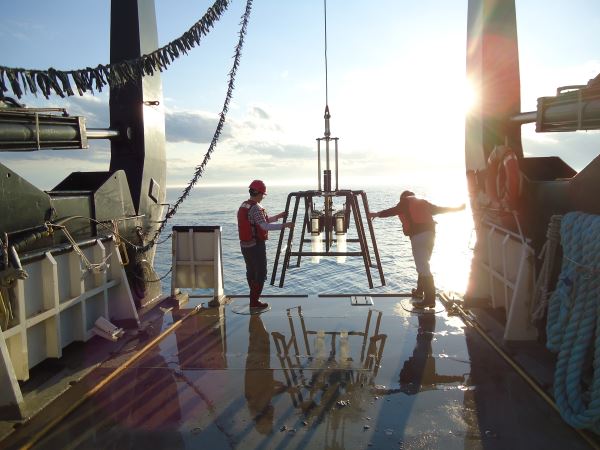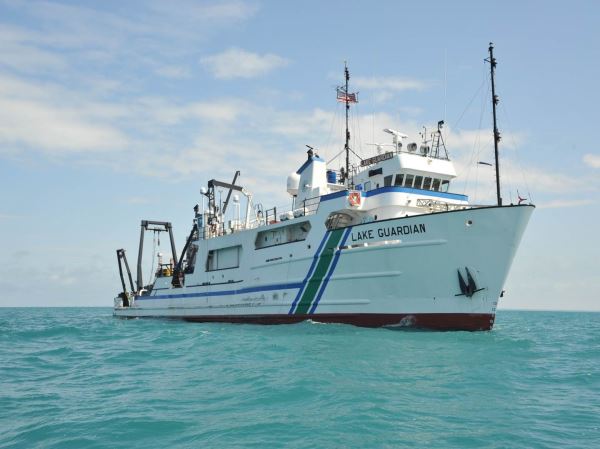In this day and age, it’s difficult to escape pollution. Nothing’s worse than tasting the smog in the air when you’re out trying to have a relacing day on the lake. As it turns out, air pollution transfers not only to the atmosphere but to water as well, lowering water quality with contaminants. In other words, air pollution has a negative impact on the Great Lakes and affects their environmental health.
Great Lakes Boating had the chance to sit down and talk about this issue with Derek Ager, a physical scientist at the Great Lakes National Program office in Region 5 for the United States Environmental Protection Agency (EPA). As part of his position, he’s also the technical lead for the Integrated Atmospheric Deposition Network.
 Entering The Water
Entering The Water
Ager explained that there’s a variety of ways that pollution ultimately ends up in the water. The first is directly from the air. There are little particles in the air that have pollution attached to them that fall into the open water of the Great Lakes, and then there’s vapor which is the general gas exchange between the water and the air. These are the two ways that air pollution enters the water.
“Then of course there’s also precipitation,” described Ager, “rain, snow, that sort of thing. The pollution is attached to the water molecules and it gets into the Lakes. There are also many tributaries that run into the Great Lakes. So anything that gets deposited in the tributaries could also end up in the Lakes.”
Air and precipitation are the main ways that pollutants get into the Great Lakes from the atmosphere.
Sources Of Pollution
When it comes to air pollution that ends up in the water, there are a variety of factors. However, the two main sources of air pollution are usually manufacturing and agriculture.
For example, there’s the general synthesis and creation of certain chemicals in manufacturing. There are chemical manufacturers that develop substances such as PCBs that the manufacturers end up emitting from their facilities.
“There’s also naturally occurring deposition of things like mercury,” added Ager. “Then there are pesticides for agricultural practices. These pesticides can transport through the air as well.”
Ager pointed out that there’s a distinction between air pollution that ultimately deposits in the Great Lakes and then general air quality. “For Great Lakes boaters who use gas for their engines, it’s more of a greenhouse gas concern,” shared Ager. “I think the biggest pollution concern for boating is generally just liquid gas running off from the engine which isn’t good.”
Other than that, there isn’t too much to be concerned about when it comes to causing air pollution when you’re out boating on the Great Lakes which is heartening.
The Fate Of Contaminants
When it comes to cleaning up the Great Lakes from contaminants, Ager encouraged thinking about the whole life cycle of a contaminant. First it gets created, it gets put in the atmosphere, it travels either through the air or the rain and gets deposited into the Great Lakes.
Most of the time, these chemicals fall out of the lake and into the sediment. This is where they end up getting stored. Other fates of contaminants include getting into live organisms.
Other fates of contaminants include getting into live organisms.
“There’s plenty of issues in the Great Lakes revolving around fish consumption,” noted Ager. “Some of the pollutants are what we call bioaccumulative. So they get into the food web and end up bioaccumulating in fish.”
Then the other big fate for pollutants is actually mussels. Mussels are filter feeders and they filter out the water. In a lot of cases, they filter out pollutants which then get stored in the mussels.
These are some of the natural end points for pollutants, but in terms of efforts to purify the water in the Great Lakes, most of the time these efforts go toward drinking water. “There are over 30 million people that get their drinking water from Great Lakes waters,” explained Ager, “so there are very intense processes that clean drinking water.”
Cleaning The Sediment
In addition, the EPA, other federal agencies, and state and local partners are working on the Areas of Concern Program which include efforts to clean up the contaminated sediment around the Great Lakes. They go out and dredge up the sediment, physically removing the contaminated sediment, disposing of it in a proper waste facility and then they usually cap the sediment. They cap the sediment so that any other toxic pollutants cannot seep up into the water from the sediment.
Other than that, the best way to keep air pollution from reaching the water is to try and reduce the input of pollutants into the air and atmosphere as much as we can. Fortunately, scientists like Ager are working to stop the adverse effects of pollutants that impact the environmental health of the Great Lakes.
United States Environmental Protection Agency
www.epa.gov

